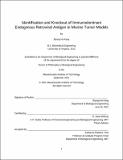Identification and Knockout of Immunodominant Endogenous Retroviral Antigen in Murine Tumor Models
Author(s)
Kang, Byong Ha
DownloadThesis PDF (9.637Mb)
Advisor
Wittrup, K. Dane
Terms of use
Metadata
Show full item recordAbstract
Advances in cancer immunotherapy have demonstrated the dominant role of T cells in an anti-tumor response, but the functional role of B cells and their antibodies in cancer remains less clear. In murine tumor models, curative immunotherapies have been previously shown to result in the development of immunotherapy-induced antibodies (iiAbs). These iiAbs were able to protect naive mice from intravenous tumor challenge and cross-react to heterologous tumor cells, motivating the identification of their antigens. Using a 2D-gel-based technique, we identified that the antigens targeted by iiAbs are the products of an endogenous retrovirus (ERV) called ecotropic murine leukemia virus (eMLV). In particular, the envelope glycoprotein (env) of eMLV was found to be the dominant cell-surface antigen targeted by iiAbs.
Based on this finding, we studied the role of anti-env antibodies in an anti-tumor response. An anti-env antibody termed 1E4 was isolated from a cured mouse by single-cell cloning, and its affinity was improved by yeast surface display of its single-chain variable fragment. Systemically administered 1E4 was efficacious in a prophylactic setting and prophylactic vaccination against env protected mice from tumor challenge. However, 1E4 did not show any therapeutic efficacy in combination with a cytokine. We found that this discrepancy in efficacy was due to the production of replication-competent eMLV by the tumor cells. Murine tumor models commonly used for preclinical studies B16F10, MC38, 4T1, and CT26 were able to produce replication-competent eMLV able to infect other murine cells in vitro and T cells in vivo.
Human tumors have not been shown to produce infectious ERV, and so we removed the infectious potential of these murine tumor models by knocking out env. The envKO tumors were more susceptible to immune control at varying degrees compared to control knockout cells in vivo. CT26 envKO tumors were spontaneously rejected and MC38 envKO tumors grew much slower compared to the control tumors. Both B16F10 and 4T1 envKO tumors were characterized by slight growth delay and 4T1 envKO tumors were found to be more susceptible to immune checkpoint blockade therapy. Single-cell RNA sequencing of untreated 4T1 envKO tumors and tumor-infiltrating immune cells revealed that 4T1 envKO tumor cells were more inflamed and CD4+ T cells and M1 macrophages were more activated.
In separate work, we used yeast surface display to develop antibodies against an inhibitory receptor CD161, which was overexpressed in clonal CD8+ T cells found in primary human glioma samples. Inactivation of KLRB1, the gene encoding for CD161, in T cells was previously found to result in higher activation and improved T-cell function. Anti-CD161 antibodies developed by yeast surface display were able to block the interaction between CD161 and its ligand CLEC2D and induce activation of T cells.
Overall, this work presents methods to identify antigens targeted by antibodies of unknown specificity and to develop antibodies against an antigen of interest. The findings in this work shed light on the pervasive problem in murine tumor models that are commonly used for preclinical studies.
Date issued
2021-09Department
Massachusetts Institute of Technology. Department of Biological EngineeringPublisher
Massachusetts Institute of Technology